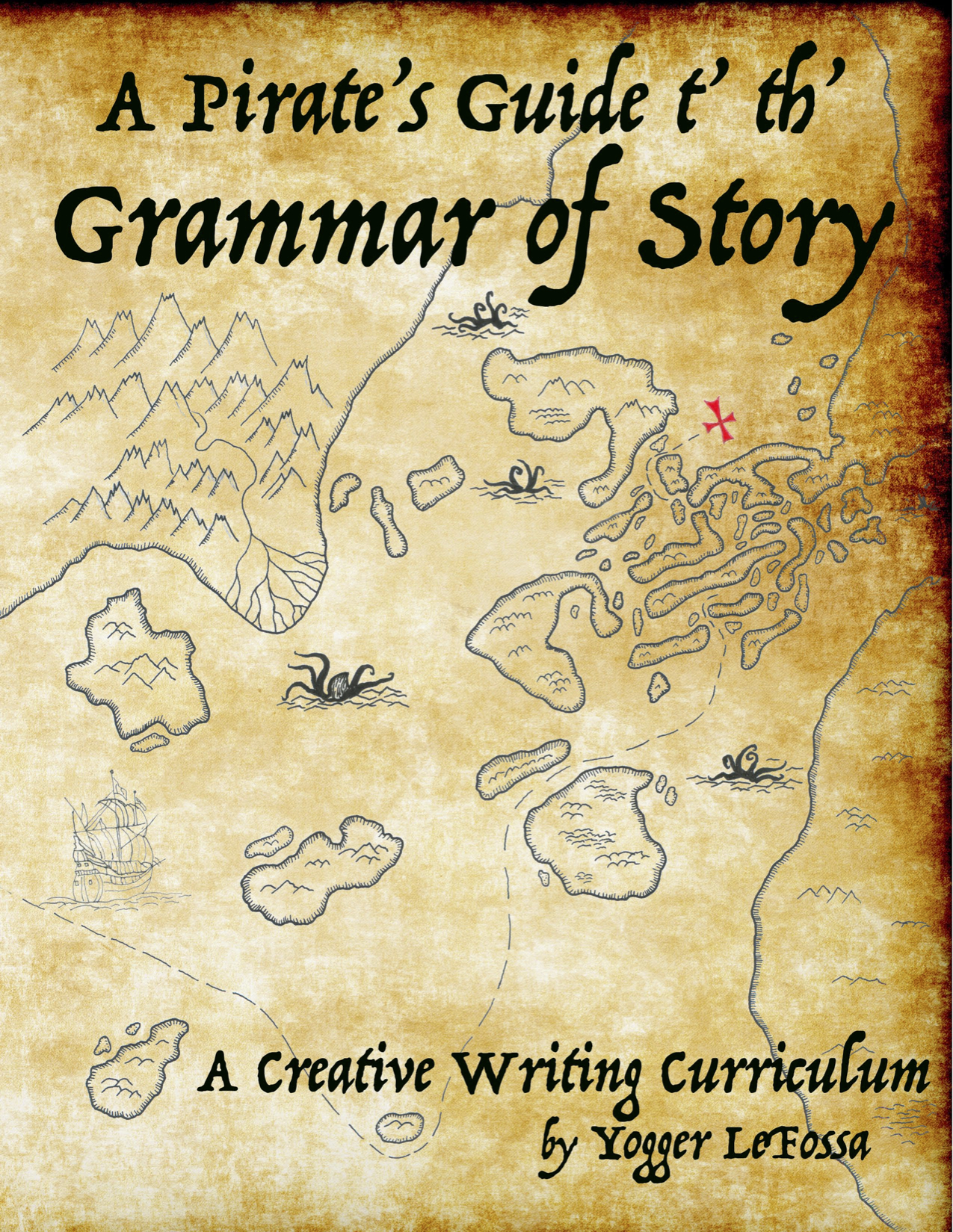The Grammar of Story
// Filed in: How To | Start Here
In keeping with our general philosophy that creativity flourishes when there are limitations, A Pirate’s Guide t’ th’ Grammar of Story takes the complexity of a Story, and breaks it down into the pieces, or elements, that create it. These are things you are certainly familiar with: setting, rules, symbols, characters, villains. There are other things that you might have heard before: beginning/middle/end, mystery, act of villainy, ticking clocks, and so on. All told, the workbook consists of 33 elements of story, with exercises for each one.
At the same time, we’ve got a pirate story that is woven in and throughout these exercises. The story is about a notorious pirate named Captain Yogger LeFossa, who captures your child and brings them aboard his ship and invites them to go on a treasure hunt, where x marks the spot. The story weaves in and out of the exercises, and the exercises themselves are involving your child in this larger pirate quest. It was done simply to make creative writing fun and interesting, and also to demonstrate these elements of story through the fictional story of these pirates, its crew of talking monkeys, and their adventures.
For a quick overview of how this workbook works, you can watch our 2 minute video flip through here.
As you can see, the exercises are directive - asking the student for specific responses, something they can easily do. Then the exercises build on each other, adding to what they’ve done before, and in the end, creating a lot of raw material for stories that you student would want to tell.
As Chris designed the curriculum, he drew not only on our experiences as homeschooling parents, but on those of the parents we interacted with in our coop groups. We didn’t want this book to be teacher intensive, but something a parent could hand to their child and have their child do. It does not intimidate, or require a lot of background or explanation, and there isn’t even a big teacher’s guide (though, after many requests for one, we’ve published one here). Instead, he designed it to be easy to use, very intuitive, and a workbook you could simply open up and start to work within. As a result, it’s something that parents and their kids can do along side each other (time permitting) - you don’t have to be teaching this. It can be a journey that the two of you can go on together. Ultimately, the goal was for this subject to be FUN. Because we believe that if you can get kids to enjoy writing, and engage with it, then they will continue to want to write.
At the same time, we’ve got a pirate story that is woven in and throughout these exercises. The story is about a notorious pirate named Captain Yogger LeFossa, who captures your child and brings them aboard his ship and invites them to go on a treasure hunt, where x marks the spot. The story weaves in and out of the exercises, and the exercises themselves are involving your child in this larger pirate quest. It was done simply to make creative writing fun and interesting, and also to demonstrate these elements of story through the fictional story of these pirates, its crew of talking monkeys, and their adventures.
For a quick overview of how this workbook works, you can watch our 2 minute video flip through here.
As you can see, the exercises are directive - asking the student for specific responses, something they can easily do. Then the exercises build on each other, adding to what they’ve done before, and in the end, creating a lot of raw material for stories that you student would want to tell.
As Chris designed the curriculum, he drew not only on our experiences as homeschooling parents, but on those of the parents we interacted with in our coop groups. We didn’t want this book to be teacher intensive, but something a parent could hand to their child and have their child do. It does not intimidate, or require a lot of background or explanation, and there isn’t even a big teacher’s guide (though, after many requests for one, we’ve published one here). Instead, he designed it to be easy to use, very intuitive, and a workbook you could simply open up and start to work within. As a result, it’s something that parents and their kids can do along side each other (time permitting) - you don’t have to be teaching this. It can be a journey that the two of you can go on together. Ultimately, the goal was for this subject to be FUN. Because we believe that if you can get kids to enjoy writing, and engage with it, then they will continue to want to write.
blog comments powered by Disqus
